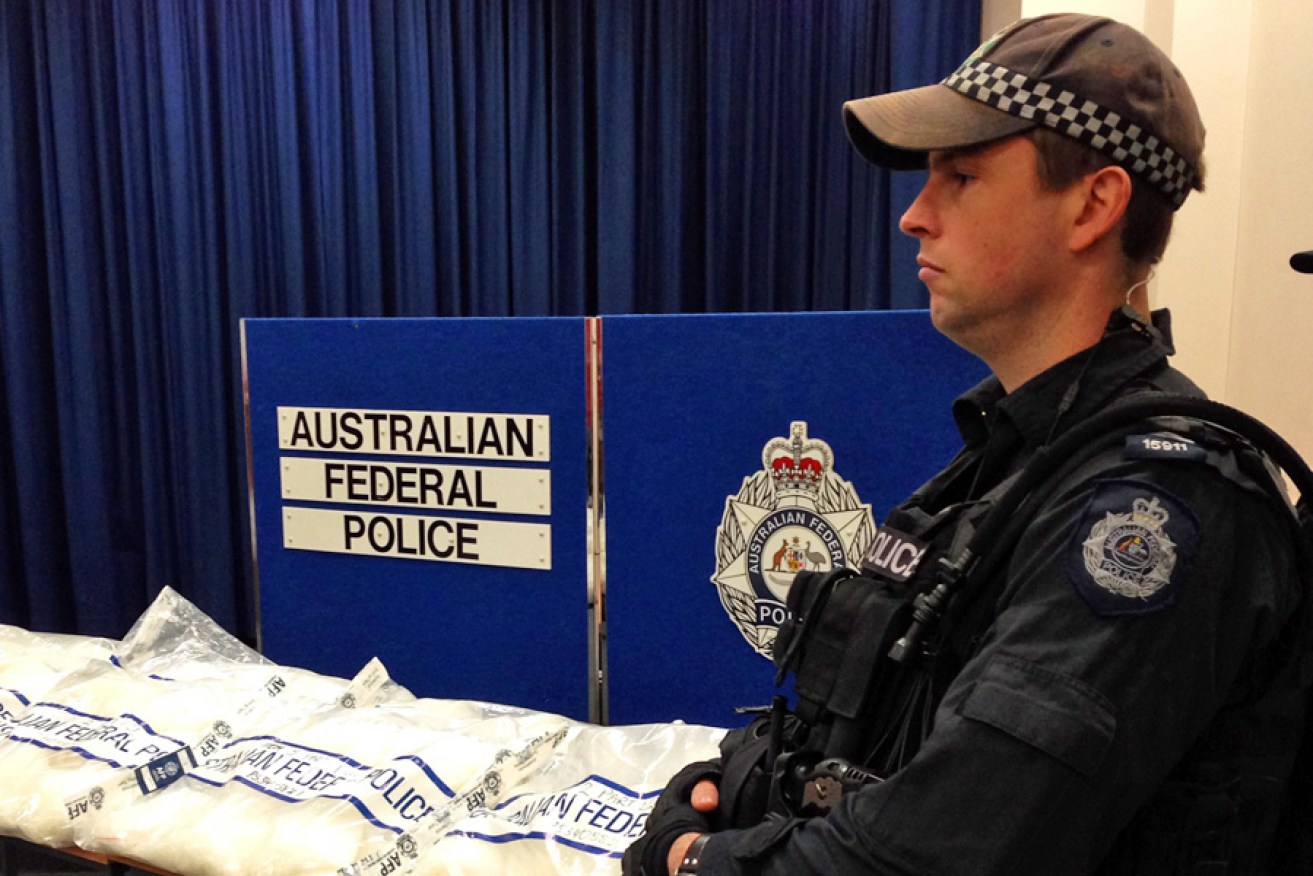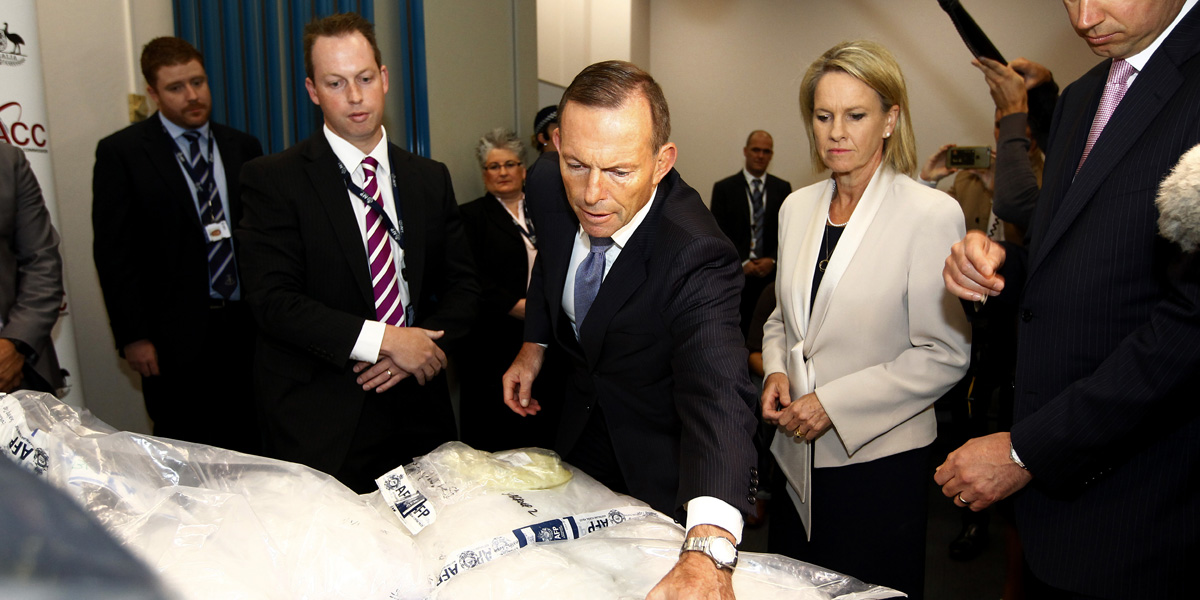Do we need to teach Ice users maths?

An Australian Federal Police officer at a press conference in Sydney on Friday to announce the seizure of 150kg of Ice.
Australia isn’t in the grip of an Ice epidemic – rather, we’re seeing a disastrous misunderstanding by users of exactly what they are taking, argues Adelaide addiction specialist Philip Crowley.
Over the last few years there has been increasing comment about the so-called Ice epidemic and this has reached near hysteria in sections of the media. But all is not what it seems.
What has really been happening is not an increase in stimulant users but a switch to a concentrated new form. Ice is around eight times as concentrated as the same amount of old forms of methamphetamine powder.
Surprisingly, there has been no price adjustment in the drug market for this more powerful product. The drug market sticks to its traditions. Potent drugs like heroin, cocaine or meth have always been sold in the same units – points (0.1gm), half weights (0.5gm) or eight balls (3.5gm). Ice is sold in the same units as old meth and generally for the same price. Buyers are getting a bottle of wine when they buy a glass, a 1000cc superbike instead of a 125cc trail bike.
The national surveys have not actually shown any increase in methamphetamine user numbers – if anything the number of meth users has actually been falling over recent years. What has happened is the number of presentations with problems from stimulant use has increased: more ambulance call outs, more hospital presentations and more people with severe psychiatric and medical illness.
What do politicians do when they don’t know what to do? Well, they form a committee. If the problem is to do with drugs then you give it a military type name, like a task force.
An epidemic is when an infection becomes widespread. What has happened with the change of users from methamphetamine powder to crystal methamphetamine or Ice is not an increase in stimulant use prevalence, but an increase in the actual virulence of the disease. Aggression, paranoid psychosis, addiction and the medical complications are directly proportional to the dose of methamphetamine taken. Ice use results in a much greater dose and so is causing much greater harm.
The increased visibility of Ice has not just fueled a wave of public concern it has also provoked a political response. What do politicians do when they don’t know what to do? Well, they form a committee. If the problem is to do with drugs then you give it a military type name, like a task force. You get to be seen as both doing things and being tough at the same time. But this heavy-handed response may be up against some powerful market forces which are not so concerned with appearances.

Prime Minister Tony Abbott inspects seized drugs after announcing his Ice taskforce in April. AAP photo
The drug market is like any other market, constantly changing as new suppliers compete for consumers. Ice is an innovation for this market which has changed the game.
Ice is synthetic: you do not need to take over a small country to grow it, like heroin or cocaine. It can be produced at everything from personal to industrial scale, using a range of different pathways and readily available precursors. The final process in its production is crystallisation. The ice-like crystals produced, always contain an extremely pure form of d-methamphetamine almost regardless of the cook.
If a half weight of Ice is the same as an eightball of speed, why not use it like it is? Meth users often have great social and psychological disadvantages but surely eight times tables are not that hard.
Ice is smoked or injected, the two ways of delivering the most rapid dose of a drug to the brain. It provokes a massive response directly to the most significant neurons in the human reward system. The brain’s response makes alcohol, other drugs, sex or even chocolate seem hardly worth the effort.
Users keep taking drugs because they find them rewarding, but even heroin users do not want to overdose. When you overdose on heroin you stop breathing and die. Overdosing on Ice is almost as disastrous.
Ice is not a sedative which mainly harms the user; Ice has often explosive impacts on those around the user. To describe someone toxic on Ice as paranoid is misleading. Ice overdose causes a form of psychosis where the person is irrationally hostile, disorganised and aggressive. With an Ice psychosis, the affected user does not typically have complicated delusions about an individual known to them – they are just threatened by anyone with whom they come into contact. Combine this with severe agitation and boundless energy and you have a serious problem. All of the disastrous medical complications of Ice, including strokes, cardiac ischaemia, cardiac arrhythmia and addiction increase rapidly as the dose reaches toxic concentrations.
Maybe we need to help users understand the dosing maths of Ice. If it is eight times more concentrated, maybe users need to use eight times less. If a half weight of Ice is the same as an eightball of speed, why not use it like it is? Meth users often have great social and psychological disadvantages but surely eight times tables are not that hard.
We need to start the response to Ice by educating existing users. We need to help them understand the much greater risks of overdose and toxicity of this concentrated form of methamphetamine.
Dr Philip Crowley is an addiction medicine specialist who works at two public hospitals in Adelaide and in private practice.




